MXA RETRO TEST: IS THE 2001 CANNONDALE MX400 READY FOR PRIME TIME?

We get misty-eyed sometimes thinking about past bikes we loved and those that should remain forgotten. We take you on a trip down memory lane with bike tests that got filed away and discarded in the MXA archives. We reminisce on a piece of moto history that has been resurrected. Here is our original test of the 2001 Cannondale MX400.
QUESTION 1: HOW FAST IS THE MX400?
It is semi-fast in a gun-and-run way. When it comes on the pipe, the Cannondale MX400 offers a brisk response, strong midrange and a decent top-end pull. It makes competitive power, but it is not as fast as a KTM 520SX, as powerful as a Yamaha YZ426 or quicker than a 250 two-stroke.
IF GOLDILOCKS RACED A THUMPER, SHE WOULD HAVE TO CHOOSE BETWEEN THREE BOWLS OF
PORRIDGE. THE CHOICES? THE ROLL-ON POWER OF THE KTM, THE GRUNT OF THE YZ426
OR THE MID-AND-UP POWER OF THE MX400.
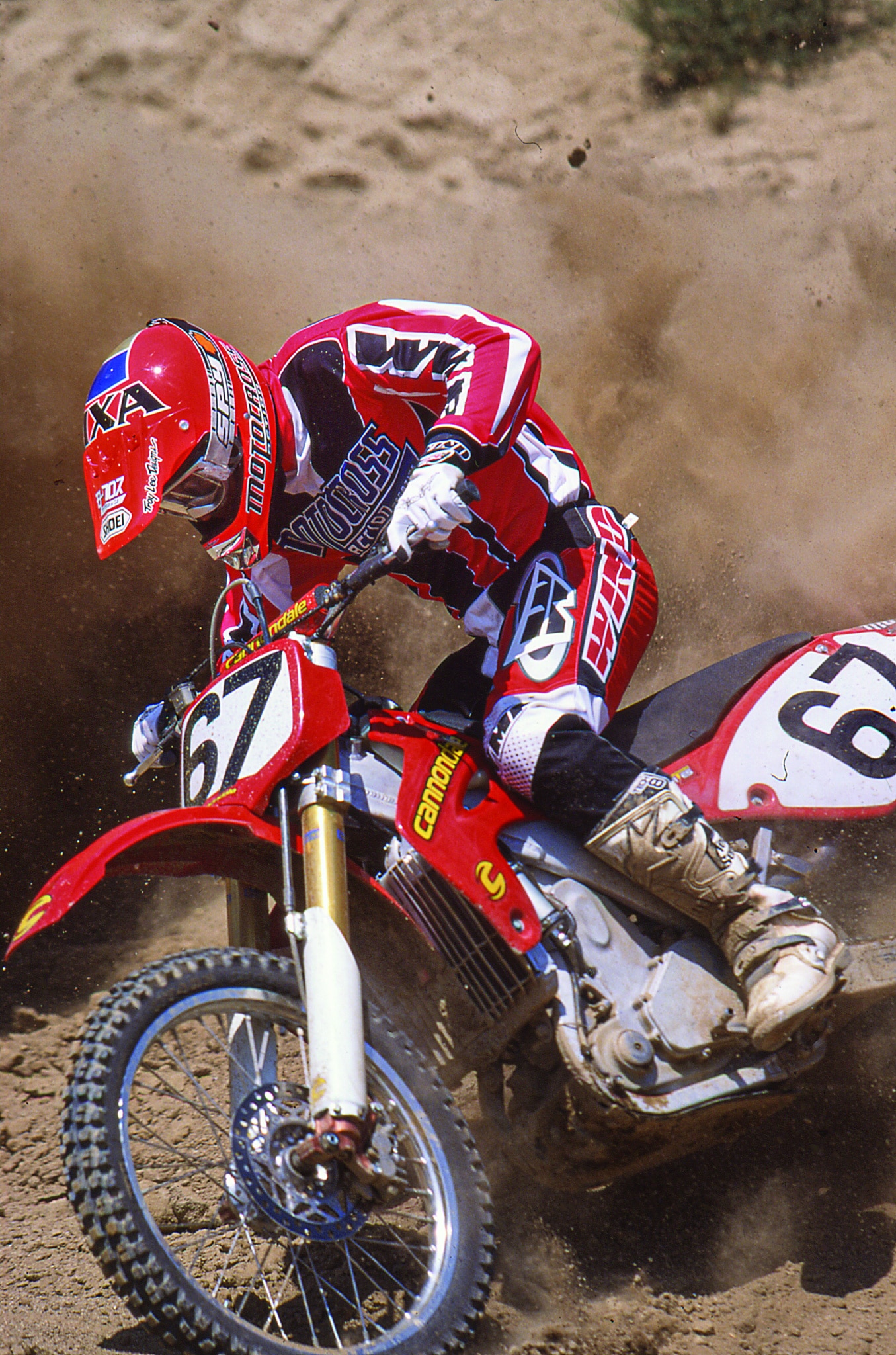
QUESTION 2: HOW DOES IT DIFFER FROM A YZ-F OR KTM?
The Cannondale MX400, Yamaha YZ426 and KTM 520SX powerbands have very little in common. Here is a quick list of the most significant YZ/KTM/Cannondale differences:
(1) The Cannondale isn’t smooth. It’s dead down low, and when it does come on, there is a surge that, from a four-stroke point of view, is decidedly un-four-stroke like. On the other hand, the KTM 520SX is smooth (with four “o’s”), while the YZ426 is torquey (with an emphasis on growl). If Goldilocks raced a thumper, she would have to choose between three bowls of porridge. The choices? The roll-on power of the KTM, the grunt of the YZ426 or the mid-and-up power of the MX400.
(2) In truth, the Cannondale MX400’s powerband is more two-stroke than four-stroke. That may sound like blasphemy for a valve-and-cam bike, but it’s the truth. The MX400 is a gun-and-run engine. It has very confused ignition timing off the bottom, and by the time the engine is ready to go, the revs are already in the midrange. To make the most of the MX400, you gas it and go, pick the next gear on the run, and go again. You don’t glide, and you don’t depend on low-rpm throttle response. It won’t pick up cleanly off the bottom, so it’s best to stay away from it.
(3) With the caveat that the Cannondale is weak down low, all three thumpers (YZ-F, KTM & Cannondale) produce unique powerbands. The YZ426 is powerful, hard-hitting and high-revving. The KTM is smooth, broad and metered. And, the Cannondale has a significant surge from mid and up.
Which one has the broadest powerband? The KTM 520SX has the most usable spread of power.
Which one has the best power? The Yamaha YZ426 has the best MX-style power.
QUESTION 3: IS CANNONDALE’S POWERBAND BETTER THAN YAMAHA’S?
No; however, it’s not as big of a handicap as Cannondale’s trouble-fraught development program could have left it. In our opinion, the Yamaha engine is the epitome of four-stroke power, offering grunt down low, tractor power in the middle and endless rpm on top. It is not an easy target for sharpshooting competitors. If Cannondale had managed to displace the YZ-F with its first effort, the snickers directed at the other Japanese makes would be deafening.
Where the Cannondale suffers in comparison to the YZ-F and 520SX is in its breadth of power. The MX400 needs power at more points along the curve. Not a single MXA test rider came back raving about how awesome the Cannondale MX400 powerband was.
On the dyno, the MX400 churns out 43 horses. That is about average for a 250 two-stroke, but down on power compared to its four-stroke competition.
 Cannondale offered advanced electronics and fuel injection in 2001, but, unfortunately, it didn’t work very well.
Cannondale offered advanced electronics and fuel injection in 2001, but, unfortunately, it didn’t work very well.
QUESTION 4: IS IT RELIABLE?
This is the most important question that any potential MX400 buyer could ask. Unfortunately, our experience with the Cannondale MX400 revealed some weak links. The MXA wrecking crew went through two engines in the first week of testing. The first one had a camshaft gear come loose, which caused the cam to go out of time and the engine to quit. The second MX400 engine had a poorly machined circlip groove on the main shaft that allowed the clutch basket to seek its own destiny (apart from the rest of the mechanism). Additionally, the rear wheels have a tendency to shed spokes.
WHERE THE CANNONDALE SUFFERS IN COMPARISON TO THE YZ-F AND 520SX IS IN ITS BREADTH OF POWER.
THE MX400 NEEDS POWER AT MORE POINTS ALONG THE CURVE.
QUESTION 5: WHAT IS THE WEAKEST LINK OF THE MX400 ENGINE?
There is a hole in the ignition mapping that makes idling the MX400 through the pits an intermittent affair. If the bike is running at low rpm, it surges, chugs and lurches as the ignition stumbles around. Even worse, if you punch the throttle, the bike will pop and die. On the track, this leads to stalling on the entrance to tight turns.
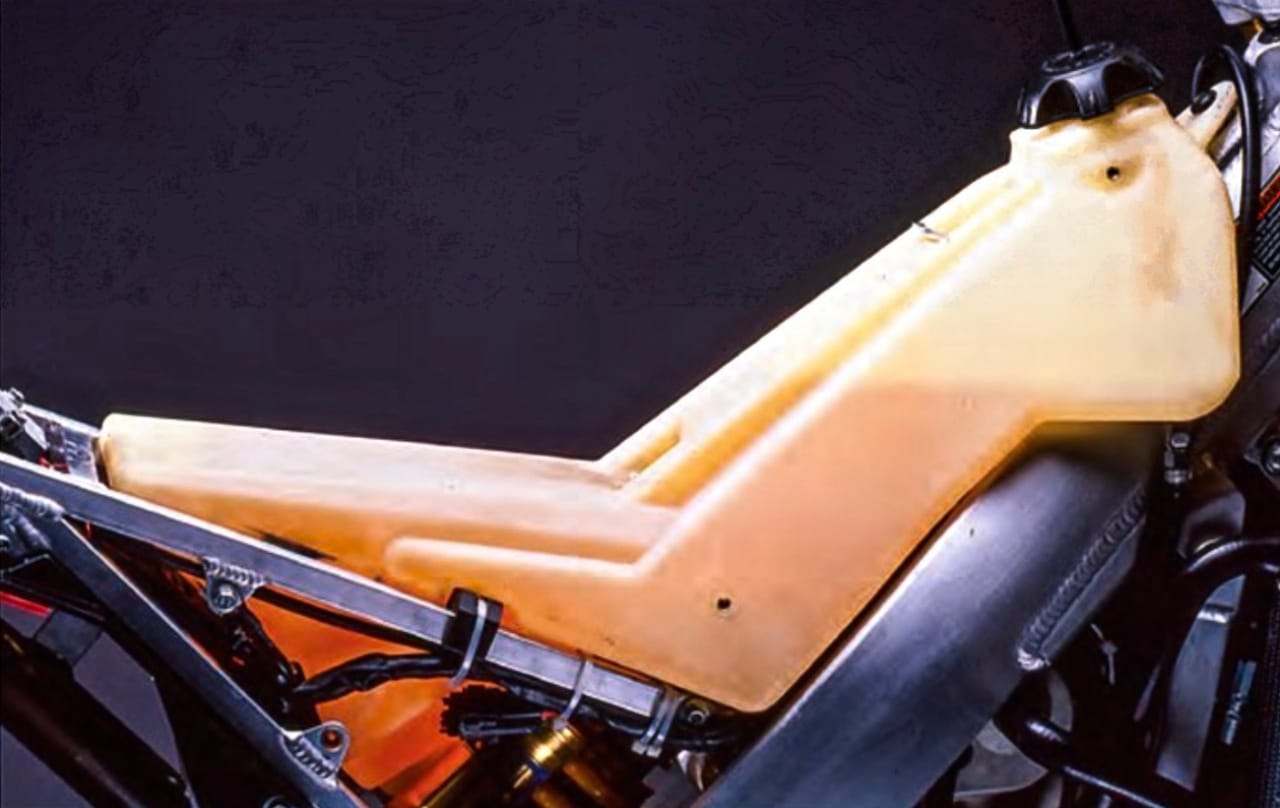 The gas tank was incredibly long, plus you had to remove it to clean the second air filter.
The gas tank was incredibly long, plus you had to remove it to clean the second air filter.
QUESTION 6: WHAT ABOUT THE ELECTRIC START?
We had higher expectations! Cannondale’s electric starter does a marvelous job of starting the MX400 in the pits (when the engine is cool); however, if you stall the bike on the track (and that is the major pitfall of four-stroke racing), the Cannondale resists getting relit. Every MXA test rider said they wished for a kick-starter in this situation. Unfortunately, the Cannondale does not have a kick-starter. It’s electric or nothing.
 Cannondale spec’ed high-end Ohlins suspension components.
Cannondale spec’ed high-end Ohlins suspension components.
QUESTION 7: IS IT LIGHTER THAN THE YZ426?
No! On MXA’s incredibly accurate scale, the Cannondale MX400 weighed 260 pounds (without gas). The YZ-F weighed 251 pounds. And, the KTM 520SX weighed 239 pounds. This is sad, because part of Cannondale’s pre-release hype was that the bike would be light. It’s not; it’s heavy. Yes, it is lighter than a Suzuki DRZ400, Honda XR400 or Honda XR650, but it gives up 21 pounds to the KTM 520SX.
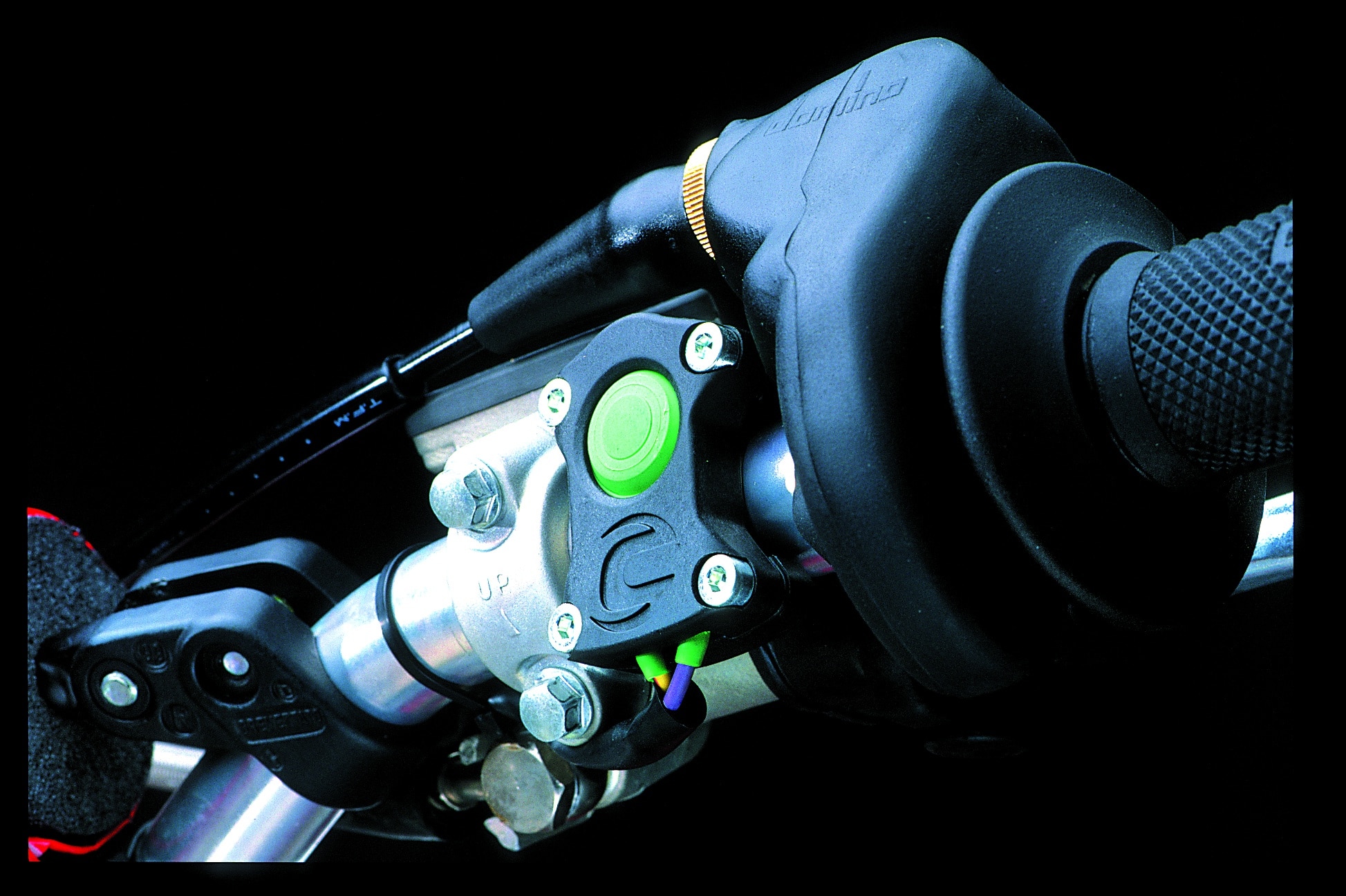 The electric-start button worked, but the electric starter was hit and miss.
The electric-start button worked, but the electric starter was hit and miss.
QUESTION 8: WHAT ARE THE BEST FORK SETTINGS?
There is no best setting. The Ohlins forks are too soft—way too soft. So soft that the front of the MX400 stinkbugs, which wreaks havoc on the handling and forces the forks to mutilate braking bumps instead of absorbing them.
If you plan to race a Cannondale MX400, you are going to need stiffer fork springs. How much stiffer? How about 0.49 kg/mm springs! That is the stiffest fork spring we have ever used, but it isn’t out of line with our Ohlins experience. When we ran Ohlins forks on our YZ400 two years ago, we used 0.47 kg/mm fork springs, which is what the Cannondale comes stock with. The 0.49s hold the front end higher in its stroke, lessen the MX400’s tendency to oversteer and keep it from diving in braking bumps
What was our best Ohlins setting? For hardcore racing, we recommend this setup:
Spring rate: 0.49 kg/mm (0.47 stock)
Oil height: 95mm
Compression: 12 clicks out
Rebound: 12 clicks out
Fork-leg height: Flush
Notes: Ohlins’ internals are similar to Kayaba forks, but the clickers are akin to Showas (compression on top and rebound on the bottom).
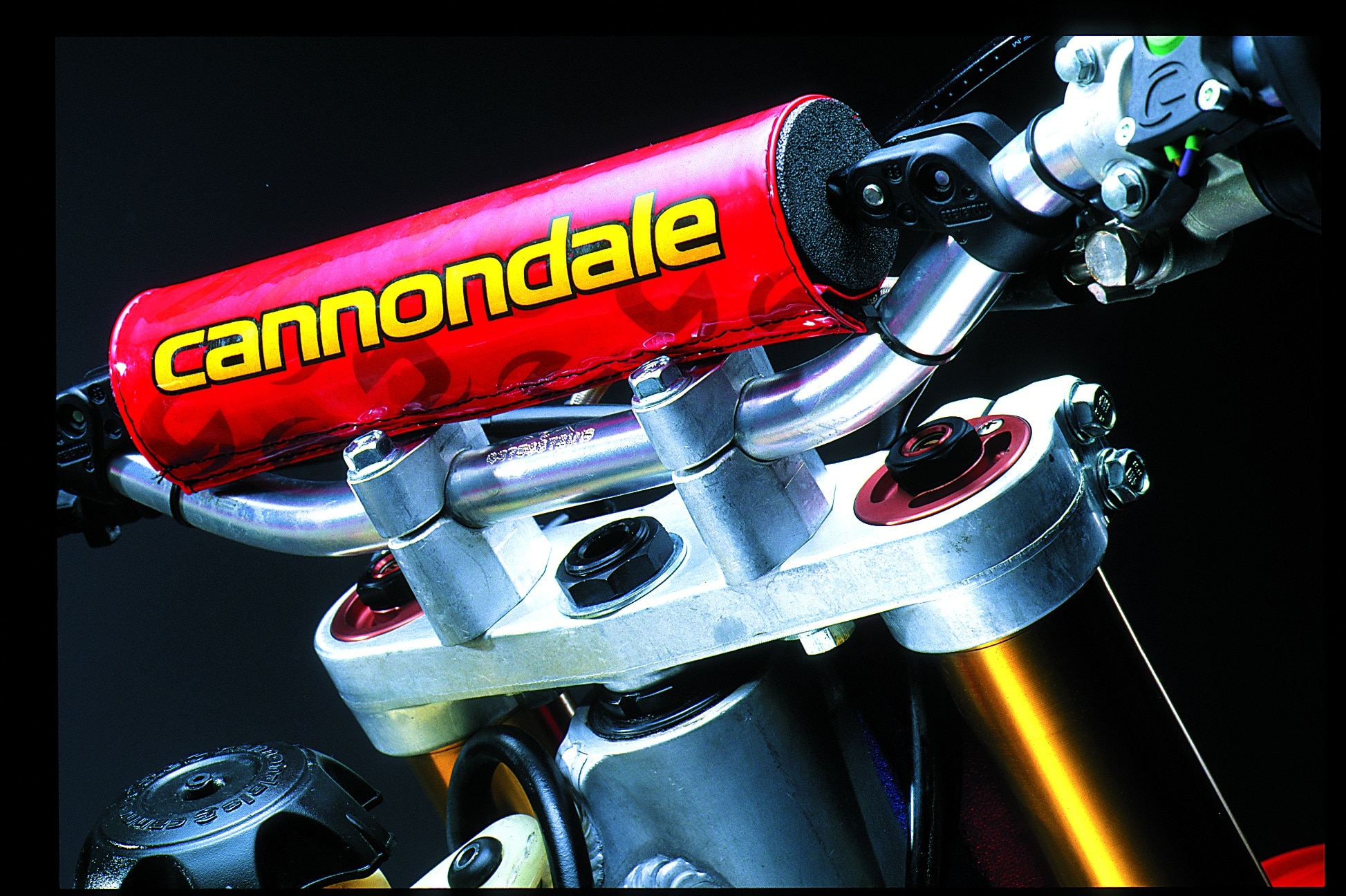 Aluminum bars and adjustable bar mounts.
Aluminum bars and adjustable bar mounts.
QUESTION 9: WHAT WAS OUR BEST SHOCK SETTING?
Cannondale is the fourth manufacturer to switch to a no-link rear suspension system (KTM, Husaberg and ATK are the other three). Like KTM and Husaberg, Cannondale uses the Ohlins’ PDS shock system (although the other two use Ohlins’ licensed WP shocks).
Not surprisingly, Cannondale has done the same three things that KTM did the first time it switched to the no-link design. (1) Non-linkage rear-suspension systems still have rising rates, but Cannondale’s rate change is too aggressive in the last half of the stroke. (2) The MX400’s rising-rate change is aggravated by the Ohlins PDS system, which uses two shock pistons. The MX400 seems to ride on the stiffer of the two pistons. (3) The 10.5 kg/mm spring rate is too stiff for anybody but the tallest and heaviest riders. We think the bike should come with a softer 10.0 spring.
The best thing about the Cannondale MX400 rear suspension is that it tracks straight, but it’s not a super-resilient rear suspension, It has a dead feeling, thumps through the braking bumps and stays high in its stroke.
Across the board, the MXA test crew rated it as an average rear-suspension system with a firm spring rate and low maintenance requirements.
What was our best shock setting?
Spring rate: 10.0 kg/mm (10.5 stock)
Race sag: 102mm
Compression: 20 clicks out
Rebound: 20 clicks out
 Why on God’s green acre would Cannondale copy the failed 1997 Honda frame?
Why on God’s green acre would Cannondale copy the failed 1997 Honda frame?
QUESTION 10: HOW DOES IT HANDLE?
Cannondale has no track record to fall back on. This is a first-year effort and doesn’t benefit from an existing philosophy. For example, Suzukis have always been twitchy, Yamahas stable and Husabergs slack, so they are expected to be twitchy, stable and slack. We had no preconceived expectations for the Cannondale MX400, but it turns out that we could have intuitively made a guess. One look at the twin-spar aluminum frame speaks volumes about the Cannondale’s heritage. It’s pure Honda. And, if push came to shove, we’d say that the 2001 Cannondale handles like a 1998 Honda CR250.
That CR heritage is both good and bad. From the saddle, the Cannondale has the feel of a 1997 to 1999 Honda. That can be extrapolated to mean that the forks have mid-stroke harshness (caused by the fact that they hang down in their travel), the rear suspension thuds through the bumps (the dead feeling emanates from the aluminum frame), and the front end has an oversteer and push glitch (just like the pre-2000 CRs).
On the positive side, the Cannondale feels familiar. It is paradoxically an unknown quantity from a known source. On the negative side, the Cannondale inherited a lot of the things that Honda has been criticized for (sort of like a computer virus) and that Honda tried to fix in 2000 and 2001. Its only ergo gaffe is that it is fat in the hind section.
ACROSS THE BOARD, THE MXA TEST CREW RATED IT AS AN AVERAGE REAR-SUSPENSION SYSTEM WITH A FIRM SPRING RATE AND
LOW MAINTENANCE REQUIREMENTS.
QUESTION 11: WHAT DID WE HATE?
The hate list:
(1) Seat It’s a big cushy pillow. Cannondale could trim it down, redesign its angles and get a firmer feel.
(2) Gas tank. MXA test riders are used to having gasoline between their legs, but on the Cannondale, we were sitting on the gas tank. The gas tank starts at the steering head and ends at your back pocket.
(3) Radiator wings. Our boots got hooked under the radiator wings. Cannondale claims they are looking into this snag. The plastic has a low-tech vacuum-form look to it.
(4) Electric starter. It has to be able to start the engine under any conditions, not just the perfect ones.
(5) Exhaust pipe. When you swing the bike up on the stand, the exhaust pipe melts through your leathers (just above the right knee). Our bike came with a Big Gun exhaust, but Cannondale says it will soon be switching to FMF pipes—and they will have a heat shield.
(6) Air filters. Yes, that is plural. The first filter is behind the front number plate. It is easy to get to and work on. The second air filter is under the gas tank. It might be easy to get to on the assembly line, but once the bike rolls out of the dealership, you have to take the bike apart to get to it. The seat, radiator wings and gas tank have to be removed. Additionally, washing your bike can allow water to infiltrate the system unless you use special Cannondale airbox covers. Nobody—and we mean nobody—wants to spend 30 minutes changing air filters.
(7) Jetting. The Cannondale does not have a carb; it has fuel injection. We wish it had a carb, because its fuel injection doesn’t work, and it makes things more complicated. To change the jetting, you need an electronic device that has to be hooked into the fuel system’s microprocessor. Motorcycles need to be user-friendly. We don’t want Microsoft to control our jetting. Additionally, the fuel injector is very sensitive to temperature change. We noticed the need to go leaner between the cool air of practice and the warmer temps of moto two.
(8) Weight. It is heavy (260 pounds) and feels heavier.
(9) Sneakers. It comes stock with Pirellis. We switched to Dunlop 739Gs (front and rear). The “G” tire is designed for the extra weight of four-strokes.
QUESTION 12: WHAT DID WE LIKE?
The like list:
(1) Clutch oil. Cannondale is the first manufacturer since the days of the British invasion to separate the clutch oil from the engine oil. It makes oil changes a pain, but it’s the best way to do it.
(2) Starting. The electric starter made our good and bad lists. When the engine is cold and you’re not in a hurry, the electric starter is sweet, but it doesn’t spin the engine fast enough to handle it when it’s hot.
(3) Jump-starting. As long as there is some juice left in the battery, you can bump-start the MX400. If the battery fails completely, you can jump-start it just as you would a car (grounded to a footpeg and to the battery’s positive post via a rear fender bolt).
(4) Brakes. Cannondale made a deal with Nissin to get its best master cylinders and calipers, and the result is very strong braking.
(5) Clutch. Except for the fact that we had to replace the main shaft to get the clutch to work, the clutch itself is decent.
(6) Petcock. Thanks to the fuel injection, there is no need for a petcock. The fuel is on whenever the electric-start button is pressed.
 Behind the front number-plate air-filter hole.
Behind the front number-plate air-filter hole.
QUESTION 13: WHAT DO WE REALLY THINK?
What do we think? Here’s the list: (1) It’s better than we thought it would be. (2) It’s faster than we thought it would be. (3) It’s heavier than we thought it would be. (4) It’s softer in the front than we thought it would be. (5) It’s stiffer in the rear than we thought it would be. (6) It’s cobbier than we thought it would be. (7) It’s harder to work on than we thought it would be. (8) It’s more gimmicky than we think it should be.
The Cannondale MX400 is a bike with unfulfilled promises. It is very much a work in progress, but, as it sits, it’s better for motocross than an XR, DRZ, VOR or Husaberg. And, perhaps by next year, it will be better than a YZ426 or KTM 520SX. It needs at least a full year of real-world development to iron out the wrinkles.


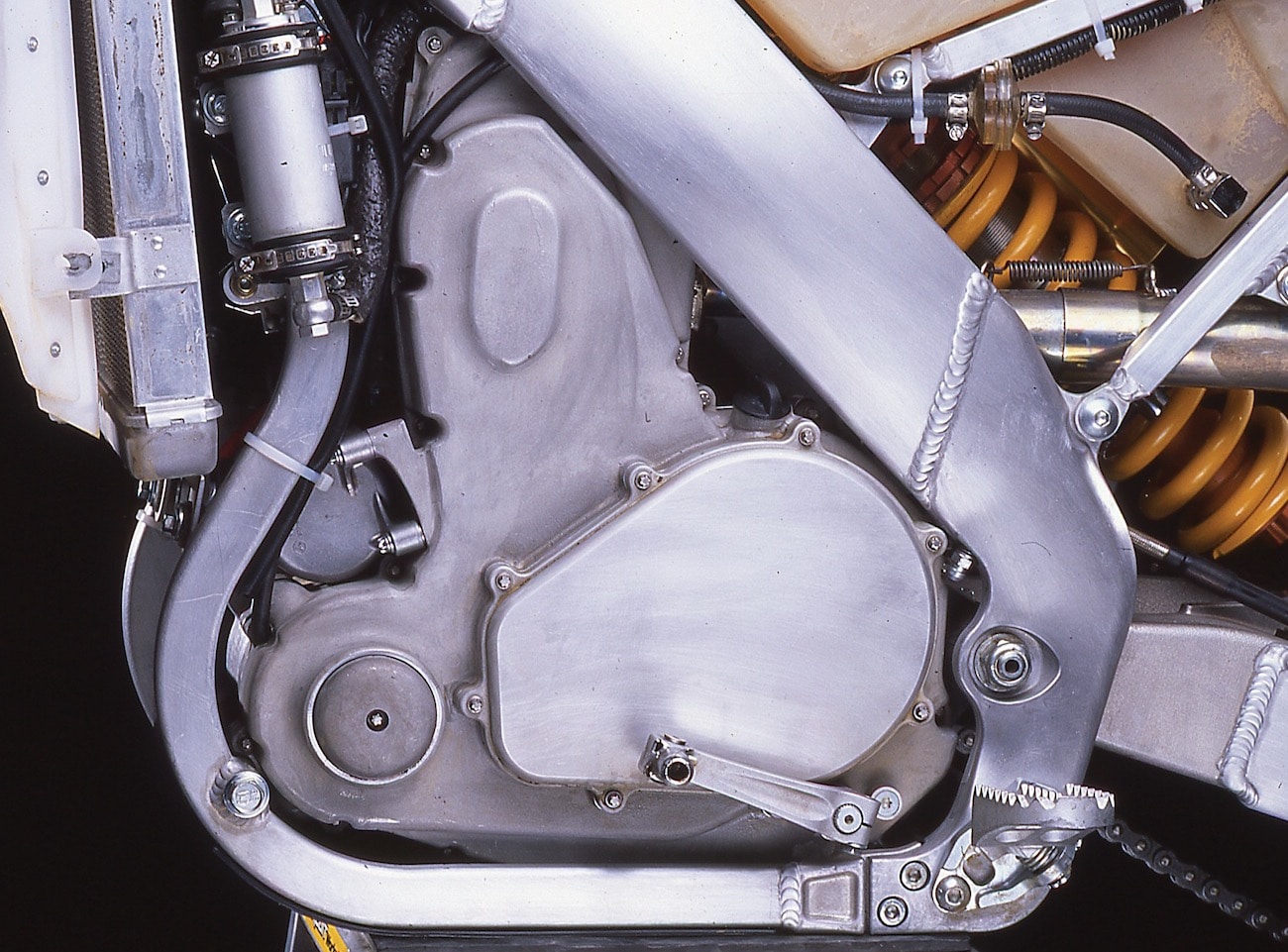


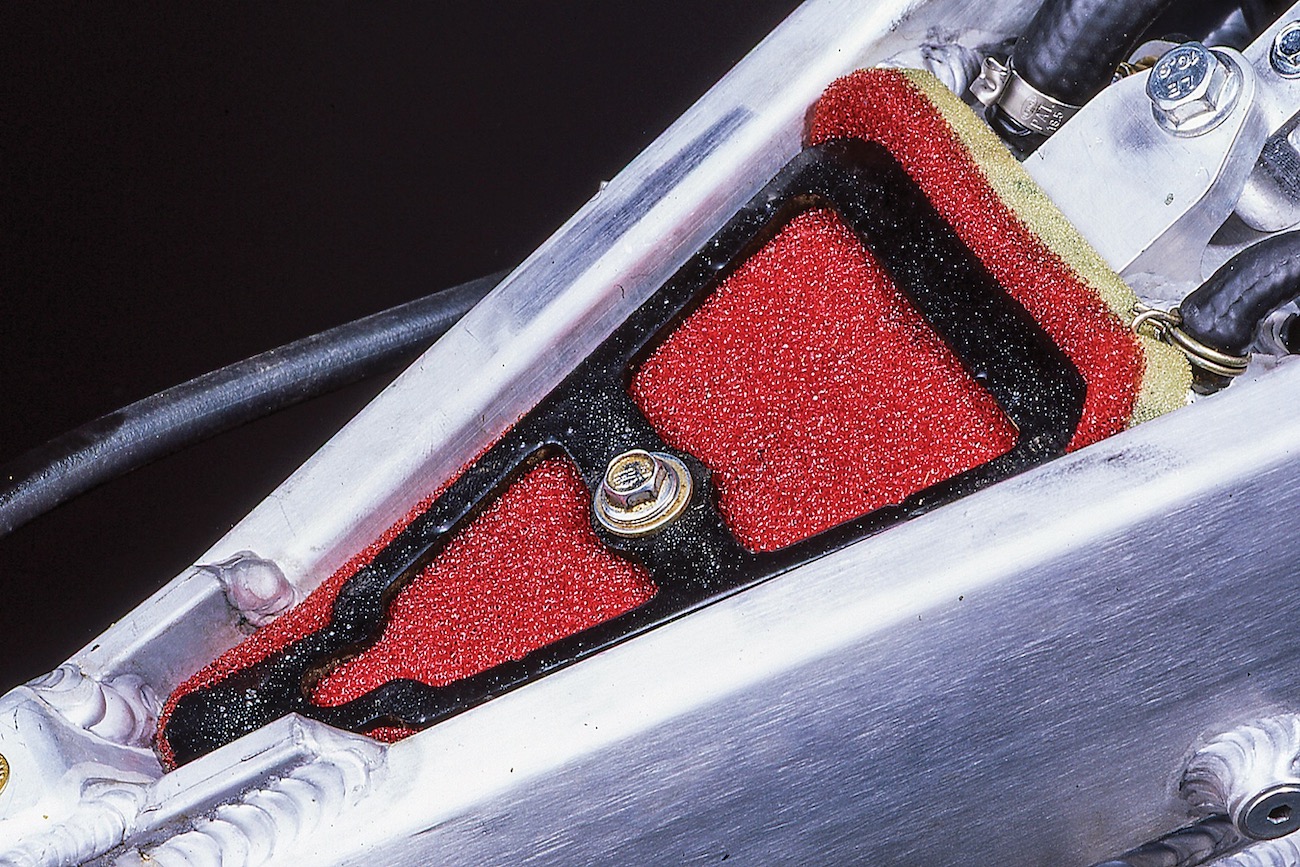




Comments are closed.